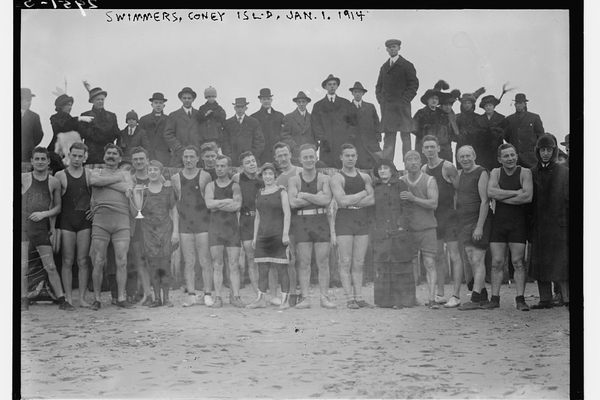7 Crazy True Stories About the Victorian Era
Plus three that are, sadly, just myths.
We can’t seem to get enough of the Victorian Era, and the denizens of that mid- and late-19th century period that saw fascinating changes in science and society. Our obsession with everything from their fashion sense to their prudery has led to countless wondrous stories. Some are mere historical embellishment (you’ve heard about those “sexy” furniture legs?) but other wacky tales are all-too-true. Here’s a collection of our favorites from the Atlas Obscura archives.
Clearing Up Some Myths About Victorian ‘Post-Mortem’ Photographs
by Sonya Vatomsky
Stories abound about post-mortem photography, in which Victorians would haul out their dead, prop them up on stands, and take a picture worth a thousand words. These stands helped corpses look alive, and allowed them to be posed with their still-breathing family members—or so the story goes. The reality was different.
The Victorian Belief That a Train Ride Could Cause Instant Insanity
by Joseph Hayes
January 1865: The peace on a regular English train journey from Carnforth to Liverpool is shattered by one man’s deranged laughter and erratic antics. Armed with a gun and attacking the windows to get to the other increasingly frightened passengers, he seems out of control. At the next train stop, the man suddenly becomes calm and serenity returns. But as the train begins to roll again, his aggression rises again. Could this have been a case of what they called “railway madness”?

The Real-Life Vampire Autopsies of the Victorian Era
by April White
In the late 19th century, vampire hunters found their prey in cemeteries—in the graves of consumption victims. Their exhumed bodies had the look of the undead; they sometimes even had blood on their lips and appeared to have gained weight in their coffins. Explore with us how tuberculosis outbreaks led to a Victorian era vampire panic in Rhode Island.
The Victorian Era’s Strange Love of Disembodied Hands
by Joshua Adair
The Victorians were, in fact, not at all averse to getting handsy: They had a cultural predilection for objectifying fingers and palms. You can see evidence of this unexpected obsession in their houseware, glasses, pitchers, and platters in the shape of the human appendage.

The Horrifying Legacy of the Victorian Tapeworm Diet
by Mariana Zapata
From foot-binding practices in Imperial China to life-threatening surgeries in modern medicine, humanity has been finding all sorts of ways to modify the body since the dawn of civilization. The Victorians were no exception to this. Among the lengths they would go through to meet the beauty standards of the day was one gruesome idea that has managed to survive—the tapeworm diet.
One of the Most Famous Victorian Dishes Is a Hilarious Lie
by Diana Hubbell, Associate Editor, Places
“Everybody in England was brought up believing in brown Windsor soup,” says Glyn Hughes, author of The Lost Foods of England. “What is really, really strange is how deep this is into the British psyche. Walk up to anyone in the street and ask them about brown Windsor soup, and they’ll say that it was terrible and horrible but everybody ate it in the Victorian era.” But the famously dreadful dish didn’t actually exist in the 19th century.

The Forgotten Victorian Craze for Collecting Seaweed
by Cara Giaimo
Beloved by figures such as Queen Victoria and George Eliot, seaweed-hunting on the coast of England was a popular way for women to tap into the enthusiasms of their era—and contribute to the burgeoning annals of science.
Victorians Wanted to Contact Aliens Using Giant Mirrors
by Sarah Laskow
Through the 19th century, a small group of serious scientists were working on proposals for extraterrestrial communication, some of which they believed might live in our own solar system. Their ideas mostly involved giant mirrors that would flash messages of contact to other planets.

How to Play a Fiery Victorian Christmas Game and Not Get Burned
by Anne Ewbank, Senior Associate Editor, Gastro Obscura
A Victorian Christmas looked a little different than what we’re used to today. For holiday fun, revelers in the United States and England scared their friends with ghost stories, told fortunes, and played boisterous party games. One such game, Snapdragon, is rarely part of anyone’s Christmas these days. After all, it involves pulling sweets from a puddle of flames.
No, Victorians Didn’t Cover Up Table Legs Because They Were Too ‘Sexy’
by Eric Grundhauser
Perhaps you’ve heard this one before: In the Victorian era, upper-crust society members were so cartoonishly prudish that it was considered proper to cover up the legs of tables or pianos, out of the fear that bare “legs” of any kind would be too evocative. In reality, this oft-repeated notion was probably just a 19th-century joke.



















Follow us on Twitter to get the latest on the world's hidden wonders.
Like us on Facebook to get the latest on the world's hidden wonders.
Follow us on Twitter Like us on Facebook